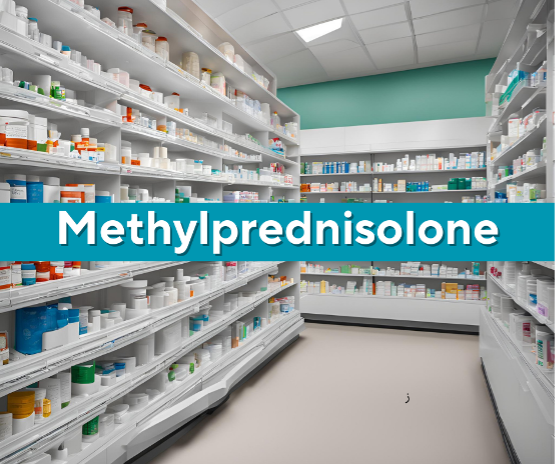Za Pharmacy
Drugs, Supplies and Delivery
Methylprednisolone
Methylprednisolone is a synthetic glucocorticoid with potent anti-inflammatory, immunosuppressive, and metabolic properties. It is widely used in clinical practice for managing a variety of conditions, including inflammatory disorders, autoimmune diseases, and allergic reactions. This article provides a detailed overview of methylprednisolone, including its mechanism of action, uses, dosage, side effects, precautions, drug interactions, and generic names, referencing authoritative sources such as the British National Formulary (BNF), Lippincott Textbook of Pharmacology, and Lange Basic & Clinical Pharmacology.
Methylprednisolone exerts its effects by binding to intracellular glucocorticoid receptors, which then translocate to the nucleus and modulate gene transcription. This results in:
- Anti-inflammatory Effects: Methylprednisolone inhibits the production of pro-inflammatory cytokines (e.g., IL-1, IL-6, TNF-α) and chemokines, reduces the migration of inflammatory cells to sites of inflammation, and stabilizes lysosomal membranes.
- Immunosuppressive Effects: It suppresses the activity of T-cells, B-cells, and macrophages, reducing the immune response.
- Metabolic Effects: Methylprednisolone increases gluconeogenesis, reduces glucose uptake by cells, and promotes protein catabolism and lipolysis.
- Endocrine Effects: It suppresses the hypothalamic-pituitary-adrenal (HPA) axis, reducing the production of endogenous cortisol.
Compared to other glucocorticoids like prednisone, methylprednisolone has a higher anti-inflammatory potency and a lower mineralocorticoid effect, making it suitable for conditions requiring strong anti-inflammatory action without significant fluid retention.
Methylprednisolone is used in a wide range of clinical conditions, including:
- Inflammatory and Autoimmune Disorders:
- Rheumatoid arthritis
- Systemic lupus erythematosus
- Asthma exacerbations
- Allergic reactions (e.g., anaphylaxis, angioedema)
- Inflammatory bowel disease (e.g., Crohn's disease, ulcerative colitis)
- Endocrine Disorders:
- Adrenal insufficiency (as replacement therapy)
- Neurology:
- Treatment of acute exacerbations of multiple sclerosis
- Management of cerebral edema
- Oncology:
- Management of chemotherapy-induced nausea and vomiting
- Palliative treatment in certain cancers
- Other Uses:
- Organ transplantation (to prevent rejection)
- Severe skin conditions (e.g., pemphigus vulgaris)
- Acute spinal cord injury (high-dose pulse therapy)
The dosage of methylprednisolone varies depending on the condition being treated, the route of administration, and patient-specific factors. Below are general guidelines:
- Oral/Intravenous/Intramuscular:
- Adults:
- Low dose: 4–24 mg daily in divided doses.
- High dose: 0.5–1.5 g/day (pulse therapy for acute conditions like multiple sclerosis or spinal cord injury).
- Children: 0.5–1.7 mg/kg/day in divided doses.
- Adults:
- Topical/Ophthalmic:
- Applied as directed, typically 1–2 times daily.
- Special Populations:
- Elderly: Lower doses may be required due to increased risk of side effects.
- Renal/Hepatic Impairment: Dose adjustment may be necessary.
Methylprednisolone is generally well-tolerated when used short-term, but prolonged use can lead to significant side effects. These include:
- Common Side Effects:
- Increased appetite and weight gain
- Insomnia
- Mood changes (e.g., anxiety, depression)
- Gastrointestinal disturbances (e.g., nausea, peptic ulcers)
- Serious Side Effects:
- Endocrine: Adrenal suppression, Cushing's syndrome, hyperglycemia.
- Cardiovascular: Hypertension, fluid retention.
- Musculoskeletal: Osteoporosis, muscle weakness.
- Ophthalmic: Cataracts, glaucoma.
- Infections: Increased susceptibility to infections due to immunosuppression.
- Contraindications:
- Systemic fungal infections
- Hypersensitivity to methylprednisolone or other corticosteroids
- Warnings:
- Use with caution in patients with diabetes, hypertension, peptic ulcer disease, osteoporosis, or psychiatric disorders.
- Avoid abrupt discontinuation after prolonged use to prevent adrenal crisis.
- Monitoring:
- Blood glucose levels
- Blood pressure
- Bone density (in long-term use)
- Signs of infection
Methylprednisolone interacts with several medications, including:
- Anticoagulants (e.g., warfarin): Increased risk of bleeding.
- Antidiabetic Agents: Reduced efficacy due to hyperglycemia.
- NSAIDs (e.g., ibuprofen): Increased risk of gastrointestinal bleeding.
- Vaccines: Reduced immune response to live vaccines.
- Enzyme Inducers (e.g., phenytoin, rifampin): Reduced methylprednisolone levels.
- Potassium-Depleting Drugs (e.g., diuretics): Increased risk of hypokalemia.
Methylprednisolone is available under various generic names and brand names worldwide. Some common generic names include:
- Methylprednisolone acetate
- Methylprednisolone sodium succinate
- Methylprednisolone base
Brand names vary by region and formulation (e.g., Medrol, Solu-Medrol, Depo-Medrol).

